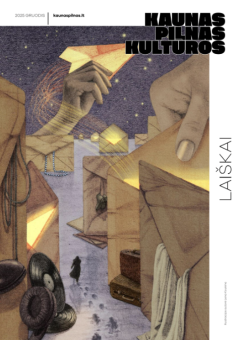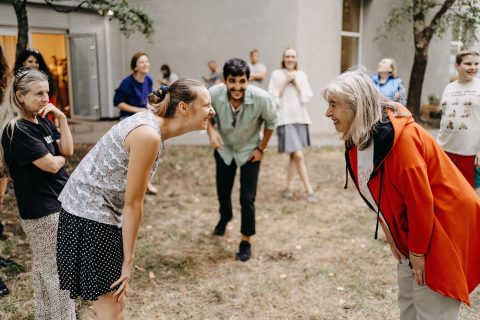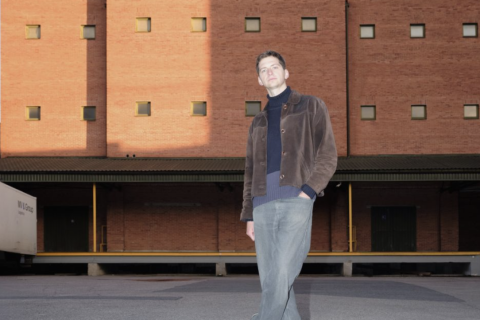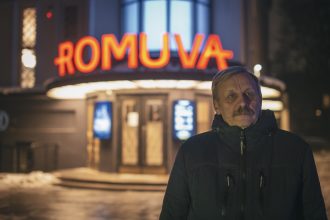It was only halfway through my conversation with Gerda Paliušytė that I realized the two seemingly separate directions in her work, which we had met to discuss, are connected geographically as well.
Her and Snieguolė Michelkevičiūtė’s photography exhibition, Lepus, will run until November 25 at the former pharmacy near Zanavykų Market. If you walk there from the city center, you will probably pass the IKI supermarket, which stands in the plot where the restaurant Žalias kalnas once stood. It was precisely there – open until morning – that dancer and choreographer Algirdas Stravinskas first began building his legend. He is the central figure, the axis, of the film Ship (Laivas) which will reach cinemas this month. But the film isn’t quite about him. Or more accurately, it’s not the kind of documentary portrait an average television viewer might expect. It is intimate, warm, attentive, and open. The photographs are much the same – the nudes never look vulgar; they rather tempt you to guess and make you feel warm inside.
Gerda, could you tell us how the works from your photography series Boys and Blue Flowers (Vaikinai ir mėlynos gėlės) ended up in the former pharmacy by the farmers’ market?
I received an invitation from Agnė Bagdžiūnaitė, the curator of the Kaunas Artists’ House event series Indecent Evenings | B.M.W. The series explores various forms and standards of masculinity. I think Agnė wanted to compare how two artists from different generations speak about masculinity and gender politics. We immediately agreed that it would be interesting to hold the exhibition outside Kaunas Artists’ House itself, that is, not in a traditional gallery space, because simply pairing us together already suggests a certain classical, museum-like approach. After a long search, Agnė found this rental space. Once the pharmacy moved out, it was left like an empty shell – one that speaks about the place and the era, while still searching for its new function.
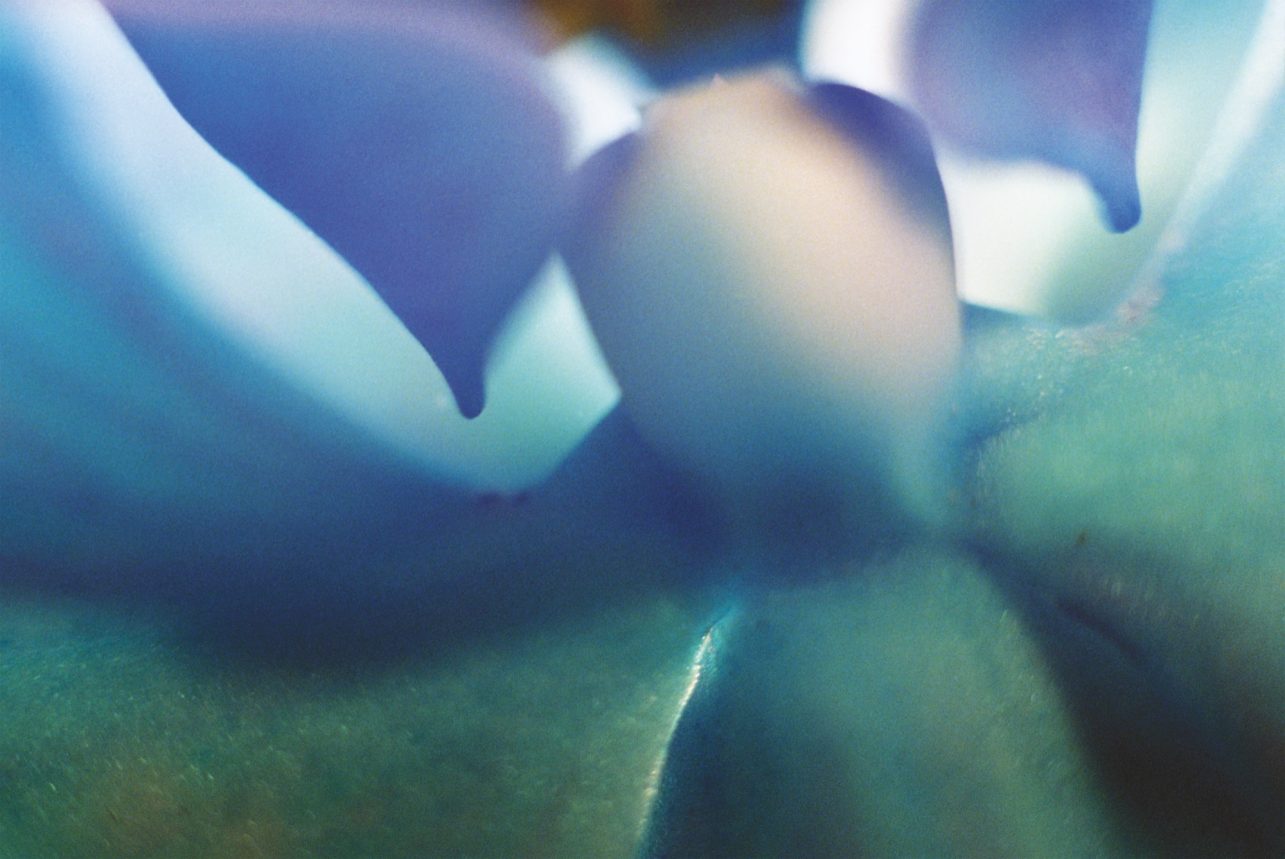
Earlier this year, I visited your exhibition at the Contemporary Art Center. That focused worldview, refining qualities and details, seemed like an interesting contrast to the large exhibition that was on in the main halls at the time. Normally, you might just skim over a nude or a flower photograph, but in your works, one feels compelled to examine the translucent texture of a petal, the fine hairs on a body. It feels as though by taking a small fragment from a larger image and magnifying it, you slow down time. The film Ship evokes very similar feelings, in which the camera, following the dancing bodies, seems to separate itself from the rest of the world. I wonder how your macro-vision and desire to observe things up close developed.
In macro photography, especially when shooting on film, with its shallow depth of field, once you focus on the foreground and move in close, the background inevitably becomes more abstract, blurred. This reminds me of the essence of the modern economy, that constant desire to have more, driven by perpetual scarcity. In photography, it’s important to me that form and content work together as a whole.
In the film Ship, the close-up gaze works on several levels. On the one hand, it’s an invitation to look closely at Algirdas Stravinskas, a figure pushed to the margins of history, and on the other, it is also a visual style. While searching for the right aesthetic for this film together with cinematographer Vytautas Katkus, we realized that close-up shots best reveal the relationships between different bodies, materials, and textures. When making a film about dance, especially about an encounter between different generations, this felt like a very fitting strategy – to create a world through half-tones and materiality.
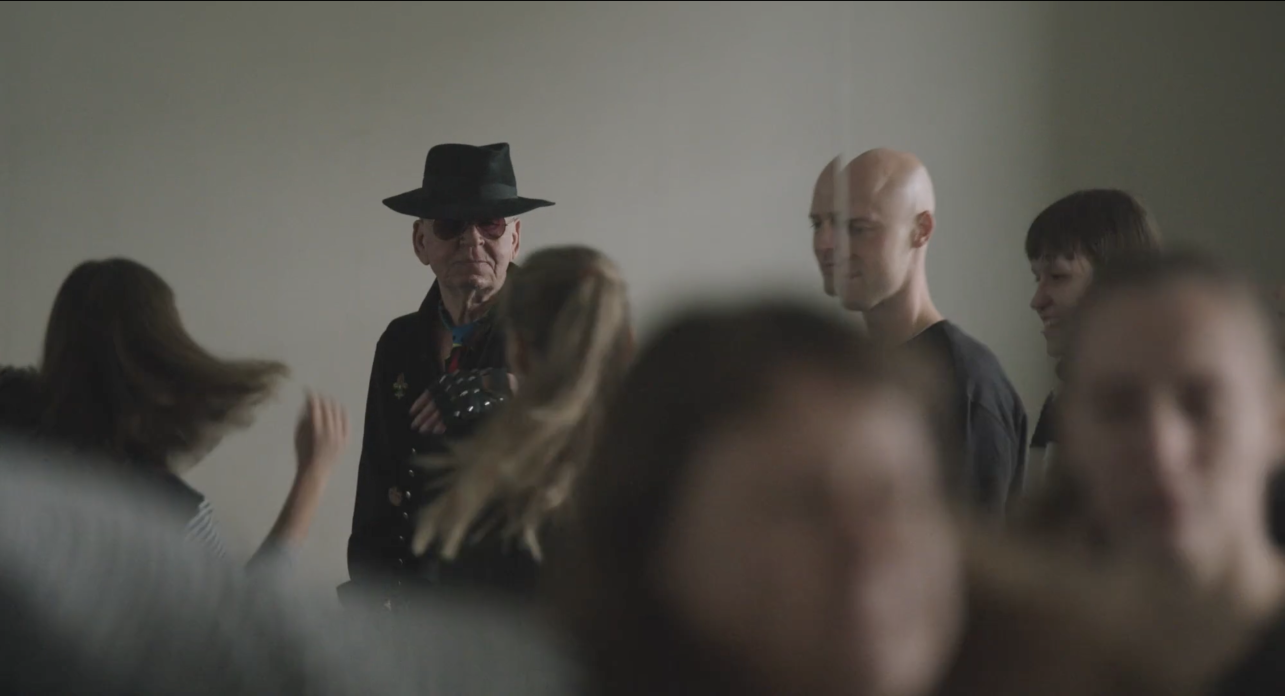
Although the “boys” in your photographs are unnamed, I’ve heard reflections from a couple of them, and I got the impression that they felt very well and comfortable, and they trusted you. This is especially important when it comes to nudes, because the line between intimacy, warmth, and vulgarity is very thin. It seems that in the film, you managed to preserve that same respect for the protagonist, without trivializing his story. How do you manage that?
Thank you for the compliment. Any close contact carries its own responsibility. I think much depends on the intention you bring. If the intention isn’t voyeuristic, if you’re not trying to deceive or circumvent the person you’re photographing or filming, then you naturally avoid the dangers you mentioned. Through conversation, more opportunities open up to understand each other and, if needed, to renegotiate mutual expectations and boundaries. That’s how mutual trust develops.
One person may feel completely comfortable being naked, while for another, intimacy arises during a conversation over coffee in the kitchen. So intimacy is not necessarily directly related to nudity. Besides, I don’t try to get people to reveal more than they want to. To be honest, I learned a few things myself in this photography project: how to make more direct contact, how to get past my own preconceptions. At first, I was shier than some of my models because I felt like I was crossing some line or messing something up.
*
Algirdas Stravinskas (born in 1953) from Kaunas is a pioneer of disco and breakdancing in Lithuania. He still wears his characteristic hat and gloves and currently lives in the capital, where he met Gerda through a mutual friend, curator Raimundas Malašauskas. The artist recalls that Algirdas wanted to socialize, go out on the town, meet new people, hang out, and sometimes he would drop by the openings of her exhibitions. “As we got to know each other, he opened up his archives – documentary material featuring his dance troupe – and that’s how I started to create the rough cut of the film,” my interlocutor, who eventually became Algirdas’ neighbor, recalls.
The conversations deepened, the idea for the film became clearer, and so did the image of Algirdas’ golden era, filled with color, psychedelia, and contradictions. Ship is a film created together with Algirdas; his figure is central, but not the only one. It is a film about an epochal shift and about the relationship between different generations and eras, in which Gerda’s neighbor participates as a connecting thread. In the film, Česlovas and Jūratė Norvaišos, who once guided Algirdas into the world of disco, share their stories, while his legend is rediscovered by the Low Air dance school team, led by Laurynas Žakevičius and Airida Gudaitė-Žakevičienė.
*
In the film, Algirdas appears as a symbolic figure frozen in time, a presence from the past. The contrast is fascinating: he himself may feel unchanged, but in a contemporary context, the differences become striking. The Low Air dancers embody this collision. How did the idea of inviting them come about?
The first idea was to find a team of dancers who could, with the participation of Algirdas himself, interpret and re-stage one of his old performances. When we met with Airida and Laurynas, together with the film’s producer and casting director, we immediately realized that working with Low Air would be the most organic solution. Their work combines several aspects that are very important to us. First, like Algirdas, they freely combine different dance styles in their work. Second, teaching and working with different generations and perspectives is very important to them as a school and a theater. Thirdly, both Algirdas’ collective and Low Air value their audience and viewership. These are different dimensions in which their experiences and Algirdas’ experiences could meaningfully converge. Most importantly, Airida and Laurynas are excellent teachers. Their respect for Algirdas, his past, and his role in the history of Lithuanian dance greatly facilitated the entire process and helped to build mutual trust.
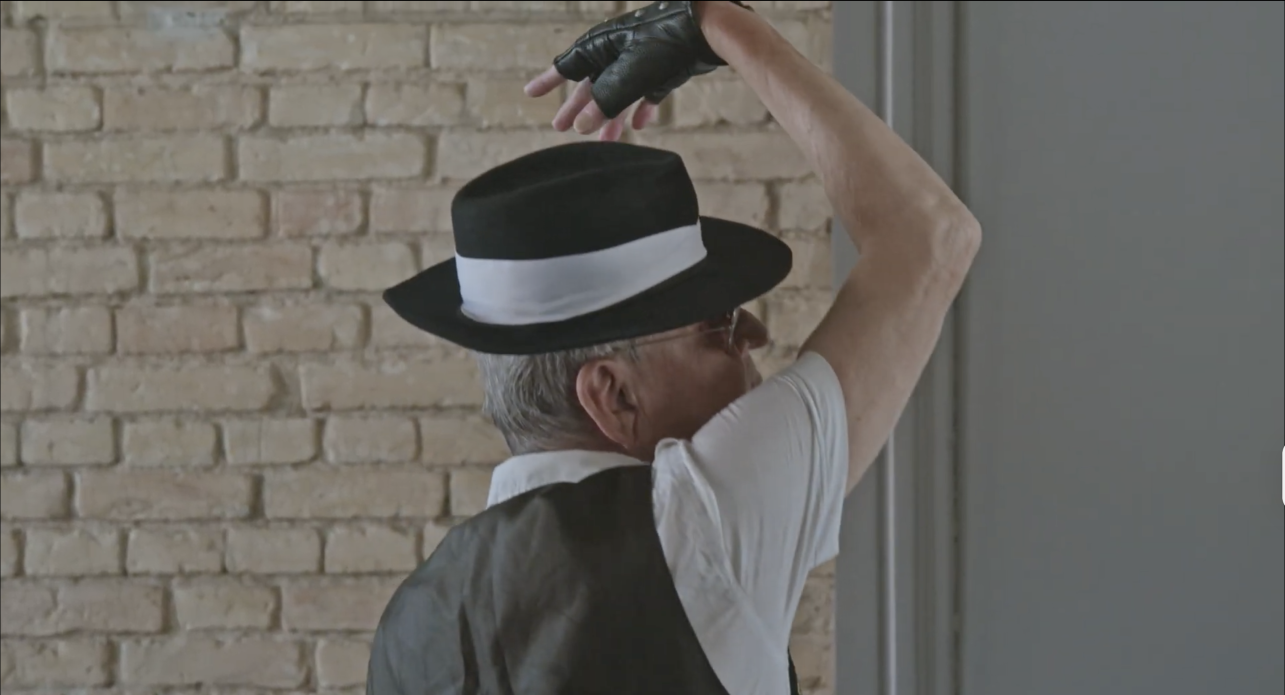
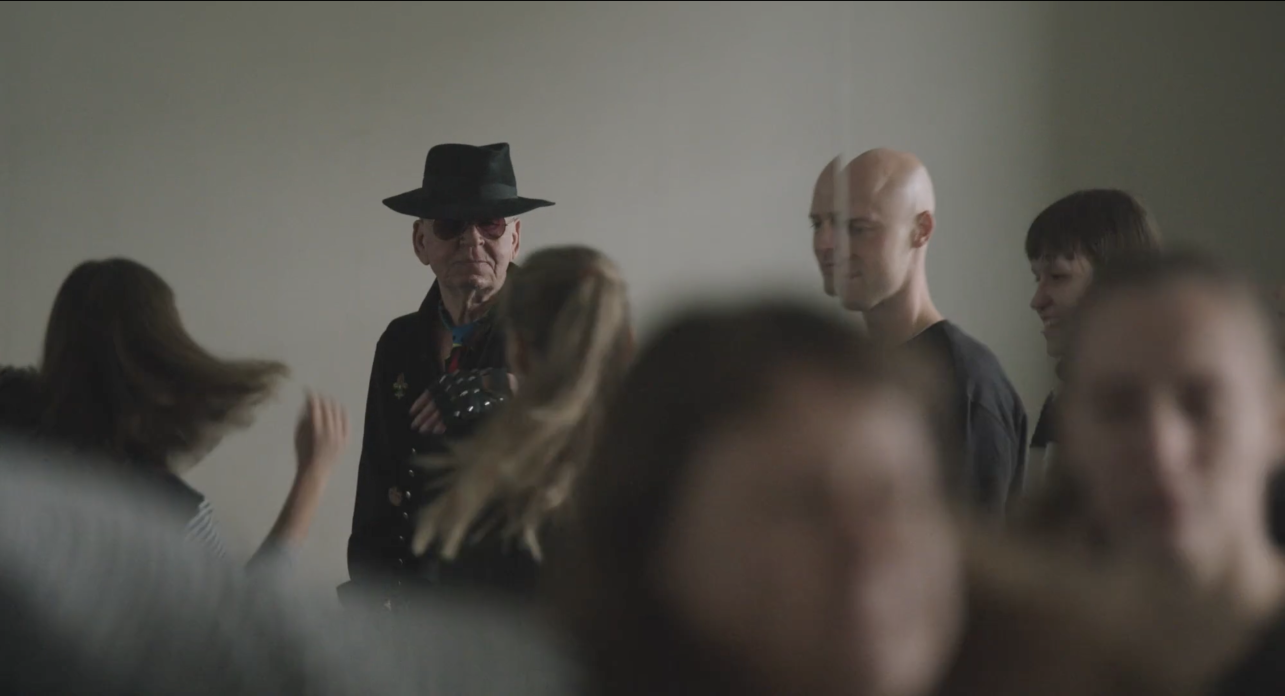
The film is called Ship, and its culminating scene – the meeting of two generations of dancers – actually takes place on a ship. It seems that this indefinite, open-water space also helps to erase unnecessary details and focus on the very essence: movement. How did you feel when you filmed this scene?
When you create a situation where a meeting is to take place, you never really know how everything will turn out in the end, whether one or another emotion you imagined will emerge. But that’s how documentary works – you define your intention and then allow circumstances to arrange themselves while you watch and record. I thought that whatever happened would be meaningful, because it would reveal what this encounter between generations truly signifies. In such a situation, there is no single correct, predetermined outcome. But the dancers – despite being of very different ages, experiences, and perspectives, and seeing each other for the first time – still found a common language; dance united them for the journey on the boat. Depicting the time spent on the boat in the film was a challenge because it required a completely different set of tools and a different approach. We edited Ship together with Gintarė Sokelytė. What helped was not only the fact that we feel and see similarly, but also because she herself participated in the filming on the ship. After all, the film doesn’t offer conclusions – only an emotional moment, which becomes the high point of the film.
Ship, as you mentioned, was filmed by Vytautas Katkus. Yet your visual signature is very strong, in both photography and film. Don’t you ever feel the urge to take the camera yourself and control everything?
Yes, such desire does arise [laughs]. That is why I started photographing. When I made my first film in 2015, I felt uncomfortable that I didn’t fully understand, didn’t feel my own visual language. That’s why I started photographing, and it helped me better understand my relationship with the image and negotiate more effectively with cinematographers about filming style. But photography is not filmmaking, they are separate artistic languages. Seeing Vytautas’ professionalism, I can only admire and enjoy our collaboration. Moreover, it’s important to me that when preparing for shoots with Vytautas, we can discuss, consider, and fairly precisely define the gaze, the composition of the frame, and the mood we want to create. During filming, I completely trust Vytautas’ eyes. He is a very flexible, sensitive, and conceptually minded creator. So most of the time, it’s simply a pleasure to let go of control and enjoy working together.
Gerda, you used to work at the Kaunas Artists’ House, where we first met. Now you have an exhibition in Kaunas, as well as a film about a prominent Kaunas personality. What is your relationship with this city?
I think it is a very important city in Lithuanian history and the current cultural landscape. Our country is too small to ignore how the history of one city or another affects the overall cultural field, so I feel enriched every time our paths cross with Kaunas. Both when collaborating with people who do a lot for their city and simply meeting them along the way. Kaunas really knows how to surprise you.
*
A sneak preview of Gerda Paliušytė’s film Ship will take place in Romuva on November 21. It is part of the closing program of the Kaunas Biennial. Tickets are now available.
Gerda’s photographic works can also be seen at the biennial itself – at the Stumbras factory and in the temporary M. K. Čiurlionis Gallery. The exhibition Lepus can be visited at Zanavykų St. 25A.
The film was produced by Smart Casual Film Production Company, founded by producers Rūta Petronytė and Justas Pocius. Ship, which will open the Vilnius Documentary Film Festival on November 27, will be accompanied on its further journey through cinemas by the company Taip toliau.
